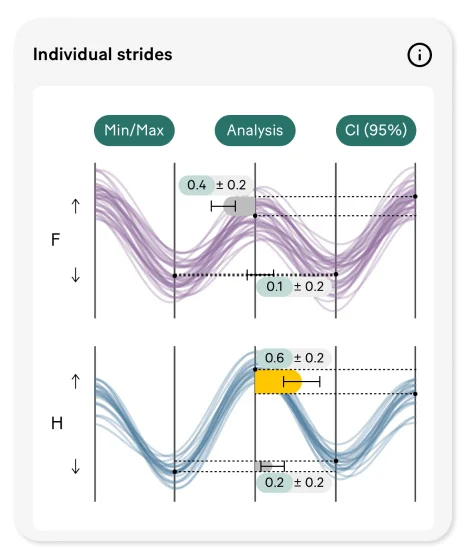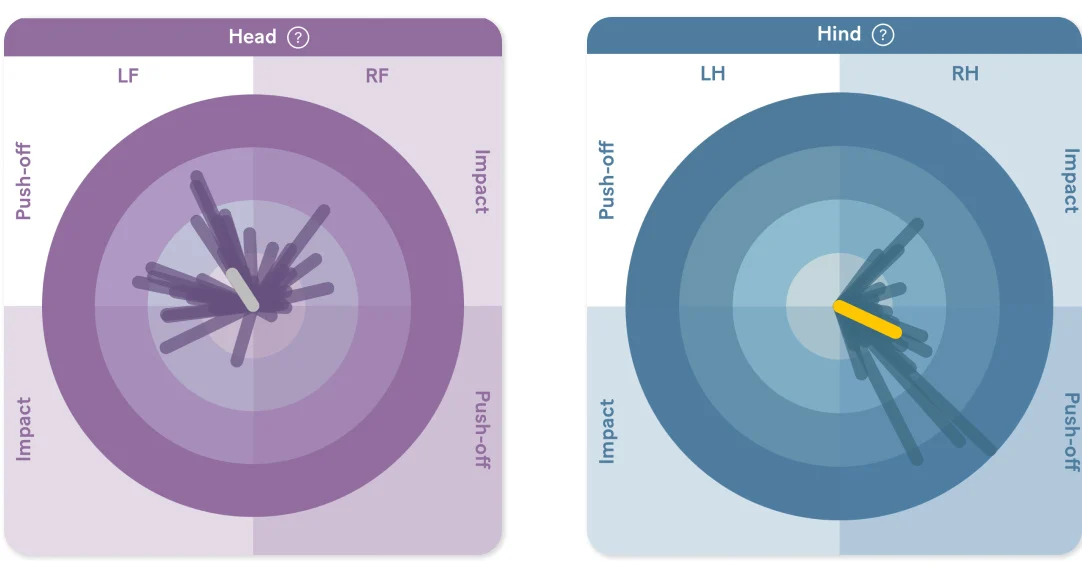
Breed: German riding pony
Gender: Gelding
Age: 14 years old
Discipline: Dressage
Notting Hill was brought to Dr. Michael Schoeberl for an examination in September 2023, following the owner’s concerns over lameness and performance issues. Two years previously, the pony was brought to the clinic with knee joint issues following an injury. The treatment at the time resulted in significant improvement, but Notting Hill is now experiencing renewed problems in the hindquarters.
RH lame, grade 1-2/5 (AAEP scale*)
Forelimb flexion tests negative
LH: Fetlock: negative, Tarsus: +/-, Knee: negative
RH: Fetlock: positive, Tarsus: ++, Knee: positive
*All lameness grades presented in this case study refer to the AAEP scale.
A baseline Sleip analysis during examination revealed a mild RH asymmetry on the straight line. Given the history of the case, the slight effusion of the right stifle and the lameness; a diagnostic anaesthesia of the stifle was performed. To objectively quantify the effect of this diagnostic block Sleip was used again.
Examination surface: Hard
This analysis is based on 38 forelimb strides. For the hind limbs, 23 strides were captured for analysis. The overview gives you an indication of the quality of the data collected in your recording, based on the consistency of the trot and the number of strides captured. Around 20 analysed strides will give you a reliable measurement. The lower the variation between strides, the more consistent and reliable the pattern.

Expect more front strides to be included as these are visible both when the horse is trotting away from the camera and when it faces the camera. The head will obscure some hind strides as the horse trots toward the camera.
A mild asymmetry in the push-off phase was detected in the right hind, indicated with yellow in the graphics. This means Notting Hill is pushing off with less force on this limb. A very mild impact asymmetry was also noted in the right hind. The left front shows a very mild asymmetry in the push-off phase.

When a horse is lame, it often compensates by altering its head movement to reduce the load on the affected limb. Typically, the head rises more when the lame limb is bearing weight and drops less when the sound limb is bearing weight. Similarly, the pelvis may drop less on the side of the lame limb during weight-bearing phases, resulting in an asymmetrical vertical displacement pattern.
In a sound horse, the head's vertical displacement will be smooth and consistent, showing a regular pattern corresponding to the horse's strides. The vertical displacement of the pelvis will also be smooth and symmetrical, reflecting even weight distribution across the hindlimbs. The amplitude of vertical displacement should be relatively symmetrical between the left and right strides.
In the individual strides section, the push-off asymmetry in the RH is quantified as 0,6, as visualised in the MinDiff.

A significant difference between the maximum and minimum vertical displacement of the head and/or pelvis suggests a significant asymmetry in gait. For example, if the Max/Min Diff is higher when the left forelimb is on the ground, the horse may be experiencing discomfort in that limb.
A larger Max/Min Diff in pelvic vertical displacement, which is the case for Notting Hill, indicates hindlimb lameness. If the difference is more pronounced on one side, it points to lameness on the corresponding hindlimb.
The asymmetry shows a consistent pattern in the right hind; with strides clustered in the pushoff quadrant. The length of the lines in the circles indicates the severity of the asymmetry. The yellow line represents the mean value of the strides analysed.

By assessing the slow-motion analysis video and data simultaneously, we can see that this outlier is caused by the first stride after turning the horse to trot away from the camera the second time.
Dr. Schoeberl administered diagnostic analgesia to the RH, starting with the medial and lateral femorotibial joints (ultrasound-guided). Subsequent Sleip analysis showed a slight improvement, but Notting Hill continued to display asymmetries, although very mild, in both the push-off and impact phases of the RH.
A second injection was administered, in the distal intertarsal joint and the tarsometatarsal joint. The positive effect was confirmed with a final Sleip analysis.

The gait analysis plots and asymmetry data from any two recordings can easily be compared in the app.
This view compares Notting Hill’s baseline recording before block with the final recording following the successful block. We can see that the RH push-off asymmetry decreased, from 0,6 (0,1) to 0,1 (0,1).

The Sleip measurements show a mild RH asymmetry with a significant decrease after blocking the hock (TMT, DIT joints).
X-ray of the RH showed:
Significant narrowing of the distal intertarsal joint with slight osteolysis
Moderate sclerosis of the third and fourth tarsal bones
Proximal Mt III (insertion of the suspensory ligament origin): No abnormalities
Osteoarthritis in the form of bone spavin in the small hock joint on the right hind
Dr. Schoeberl administered a joint supplement (HY Synvet) and an anti-inflammatory medication (Celestovet), into the TMT and DIT joints, confirmed with X-ray. Additionally, 10 ml of pain relief medication (Flunidol) was given intravenously.
Notting Hill was ordered to stall-rest for two days, followed by hand-walking 30 minutes daily for a week. After four weeks, a follow-up and re-check, referred to the owner's local vet, was carried out.
Some six months later, Notting Hill is still sound and working.